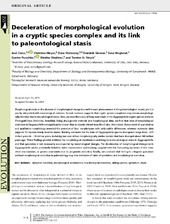Deceleration of morphological evolution in a cryptic species complex and its link to paleontological stasis
Cerca, Jose; Meyer, Christian; Stateczny, Dave; Siemon, Dominik; Wegbrod, Jana; Purschke, Günter; Dimitrov, Dimitar; Struck, Torsten H
Peer reviewed, Journal article
Published version

Åpne
Permanent lenke
https://hdl.handle.net/1956/22942Utgivelsesdato
2020Metadata
Vis full innførselSamlinger
Originalversjon
https://doi.org/10.1111/evo.13884Sammendrag
Morphological stasis or the absence of morphological change is a well-known phenomenon in the paleontological record, yet it is poorly integrated with neontological evidence. Recent evidence suggests that cryptic species complexes may remain morphologically identical due to morphological stasis. Here, we describe a case of long-term stasis in the Stygocapitella cryptic species complex (Parergodrilidae, Orbiniida, Annelida). Using phylogenetic methods and morphological data, we find that rates of morphological evolution in Stygocapitella are significantly slower than in closely related taxa (Nerillidae, Orbiniidae). Assessment of quantitative and qualitative morphology revealed the presence of four morphotypes with only subtle differences, whereas molecular data supports 10 reproductively isolated clades. Notably, estimates for the time of Stygocapitella species divergence range from 275 million years to 18 million years, including one case of two morphologically similar species that have diverged about 140 million years ago. These findings provide evidence for morphological deceleration and long-term morphological stasis in Stygocapitella, and that speciation is not necessarily accompanied by morphological changes. The deceleration of morphological divergence in Stygocapitella can be potentially linked to niche conservatism and tracking, coupled with the fluctuating dynamics of the interstitial environment, or genetic constraints due to progenetic evolution. Finally, we conclude that failing to integrate speciation without morphological evolution in paleontology may bias estimates of rates of speciation and morphological evolution.
